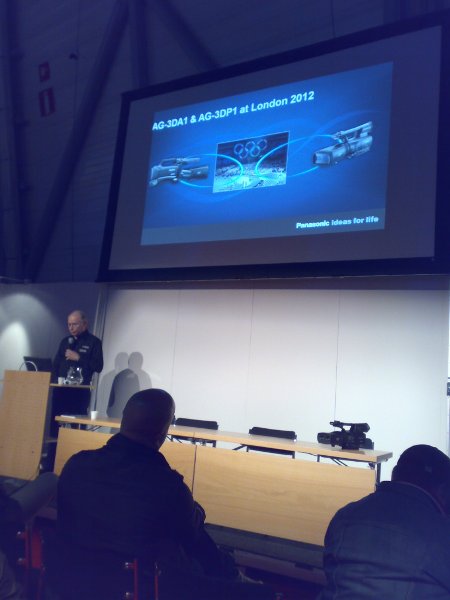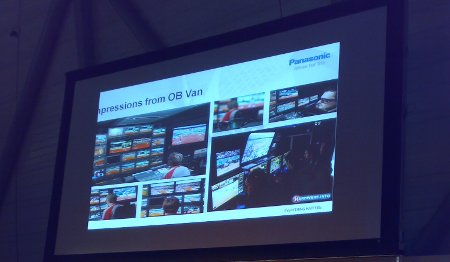I visited AudioVisual 2011 trade show briefly on 13. November 2011. The most interesting stuff I saw there was a presentation on shooting 3D video with Panasonic equipment. The presentation was given by Juha Lindqvist from Kaukomarkkinat. I originally planned to write an article on 3D video technology for Prosessori magazine, but because Prosessori magazine publication ended I have no reason to hold this material for a longer time.
Here are some notes I made from the presentation now presentation that I found interesting (have been interested in 3D technologies for long time and I have TV production experience from AssemblyTV).
Panasonic has been for several years been very active on live 3D TV productions. They provided the technology for 3D shooting of 2009 French Tennis Open. The entire 2011 French Tennis Open, Roland Garros, was broadcast live in 3D to over 17 countries across Europe. And several other events.
Panasonic has nowadays two main 3D TV camera models: AG-3DP1 and AG-3DA1. AG-3DA1 was the first integrated twin-lens full HD 3D camera recorder on the market. The AG-3DP1 is a newer P2HD Series integrated twin-lens 3D camera recorder. They are nowadays the main tools for 3D TV production. In addition to this also a side-by-side rig with two AK-HC1800 are used to shoot 3D TV material.
In 3D TV production setup each 3D camera has two HDSDI outputs: one for HD picture for left eye and other for HD picture for right eye. Those video signals go to 3D video capable video mixer that is used in the same way as normal TV production video mixer. At the moment AG-HMX1000 mixer (2/4 cameras) and AV-HS450 (16 ch 2D upgradeable to 9 ch 3D mixer). The monitoring of the 3D video is done on 3D capable LCD monitors and 3D glasses (shutter technology).

I earlier wrote that BBC plans to use 3D on London Olympics at summer 2012. The presentation gave some details on the actual 3D TV production hardware that is planned to be used on London Olympics. Panasonic has been for a long time been the company that has provided to TV broadcasting cameras and related equipment for Olympics for a long time. So practically all TV camera gear (2D and 3D) will be from them. The main 3D camera models to be used on London 2012 will be AG-3DA1 and AG-3DP1 (also two AK-HC1800 rig may be used). The video mixers will be AG-HMX1000 and AV-HS450. The 3D video monitoring will be done with BT-3DL2550 monitors.

8 Comments
Tomi Engdahl says:
New tech makes four-camera 3D shooting possible
http://www.innovationtoronto.com/2011/09/new-tech-makes-four-camera-3d-shooting-possible/
When it comes to producing 3D TV content, the more cameras that are used to simultaneously record one shot, the better.
At least two cameras (or one camera with two lenses) are necessary to provide the depth information needed to produce the left- and right-eye images for conventional 3D, but according to researchers at Germany’s Fraunhofer Institute for Telecommunications, at least four cameras will be needed if we ever want to achieve glasses-free 3D TV.
New tech makes four-camera 3D shooting possible
http://www.gizmag.com/stan-calibrates-four-3d-cameras/19831/
At least two cameras (or one camera with two lenses) are necessary to provide the depth information needed to produce the left- and right-eye images for conventional 3D, but according to researchers at Germany’s Fraunhofer Institute for Telecommunications, at least four cameras will be needed if we ever want to achieve glasses-free 3D TV. Calibrating that many cameras to one another could ordinarily take days, however … which is why Fraunhofer has developed a system that reportedly cuts that time down to 30 to 60 minutes.
The STAN assistance system ensures that the optical axes, focal lengths and focal points are the same for each camera. That way, as the viewer moves their head, the combined shots will all look like one three-dimensional shot.
The four-camera setup is already in use by members of the MUSCADE project, which is a consortium dedicated to advancing glasses-free 3D TV technology.
Tomi Engdahl says:
Movidius teams with Toshiba on 3-D camera system
http://www.edn.com/article/520753-Movidius_teams_with_Toshiba_on_3_D_camera_system.php?cid=EDNToday_20120201
Fabless mobile multimedia chip company Movidius Ltd has announced it has partnered with Toshiba Electronics Europe and developed a reference design of 3-D image capture system for integration by camera module makers.
In the design the MA1178 video processing chip from Movidius (Dublin, Ireland) operates with two MIPI standard streams from Toshiba image sensors at up to 8-Mpixels resolution. The chip works with EDoF (extended depth of field) cameras and can compensate for camera sensor differences or minor misalignments, Movidius said.
Tomi Engdahl says:
Panasonic falls to a £1.6bn.loss as demand dries up
Blames floods and the European crisis
http://www.theinquirer.net/inquirer/news/2143922/panasonic-falls-gbp16bnloss-demand-dries
a 14 per cent decline from the same quarter a year previously. That led to Panasonic suffering an operating loss of £1.6bn.
Panasonic is not expecting things to get better soon, with the firm announcing a downward revision of its revenue estimate for its full year 2012
Tomi Engdahl says:
3D Smart Vision Simplifies 2D Factory Inspection
http://www.designnews.com/document.asp?doc_id=235830&cid=NL_Newsletters+-+DN+Daily
Even if a factory inspection system doesn’t need 3D stereo vision, the tool can simplify 2D image processing. Two synchronized 2D cameras can create stereo 3D images that help adjust for different heights or depths of objects going down the line or being guided on and off pallets.
Combining stereo 3D with smart camera technology in a rugged handheld system, such as QuantumVision’s Hammerhead, is a relatively new idea.
“In many applications, vision system engineers don’t really care about the stereo 3D info, like robots with sophisticated 3D vision that already has much higher accuracy in the Z dimension than stereo 3D can provide,” Robert Blenis,
Tomi Engdahl says:
Innovation at home: Inside a 3-D desktop scanner
http://www.eetimes.com/design/signal-processing-dsp/4208834/Innovation-at-home–Inside-a-3-D-desktop-scanner-semiconductor?Ecosystem=communications-design
Tomi Engdahl says:
London 2012 Olympic Games Going for the Gold
http://www2.electronicproducts.com/London_2012_Olympic_Games_Going_for_the_Gold-article-FANE_London_Olympics_June2012-html.aspx
With the London 2012 Olympic Games just 51 days away, what can viewers expect?
During the 2008 Beijing Olympics, one of the most watched events in TV history, viewers witnessed some interesting tech feats:underwater skateboard cameras, rain preventing missiles, and the 8,000-fps camera, just to name a few.
How can London top that?
For starters, Panasonic Corporation of North America and the NBC Sports group have teamed up to bring viewers over 200 hours of 3D Olympic coverage in what will be a first for the Olympic Games.
Panasonic’s 3D production technology, the AG-3dP1 Integrated Twin-Lens 3D Camera Recorder, will make this possible. The AG-3dP1 has a 17-times twin-lens, zoom-lens system that ranges from wide-angle to telephoto in order to adjust to different scenarios. The opening and closing ceremonies, as well as diving and gymnastics, are just some of the events scheduled to be broadcast in 3D. The technology will be available in the U.S. to distributors who carry Olympic coverage on cable and satellite.
For the athletes, technological improvements will aid in effectiveness and accuracy.
sport says:
My boss is also eager of YouTube comic video tutorials, he also watch these even in office hehehe..
3d Viewer says:
I want to say thanks for an interesting website about